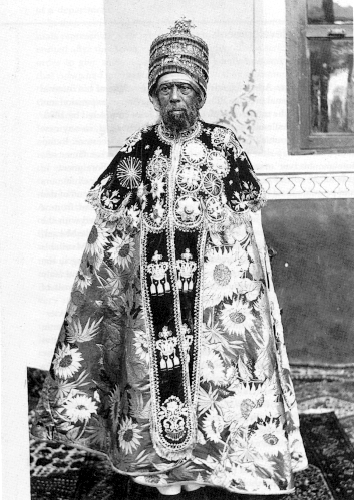Douglas Yaney Gallery
African Tribal Art - Haitian Paintings
Home Page
Contact Us
Purchasing Information
Museum Quality African Art
African Tribal Masks
African Tribal Figures
African Tribal Utilitarian Objects
Back to Lion Skin Cape made for Emperor Menelik, II of Ethiopia
Emperor Menelik II of Ethiopia
(1844 - 1913)
Proclaimed to be a descendant of the legendary Queen of Sheba and King Solomon, Menelik II was a dominant figure of his time in Africa and would be known as the King of Kings. He converted a group of independent kingdoms into the strong, stable empire known as the United States of Abyssinia, otherwise known as Ethiopia. His feat of pulling together several kingdoms, which often fiercely opposed each other, earned him a place as one of the great statesmen of African history. His further accomplishments in bringing Ethiopia into the twentieth century, coupled with his stunning victory over Italy in the 1896 Battle of Adwa, in their attempt to invade his country, placed him among the great leaders of world history and maintained his country's independence until 1935.
Menelik II was Emperor of Ethiopia from 1889 until his death in 1913. He was originally ras or ruler of Shoa in central Ethiopia. After the death in 1868 of Emperor Tewodros II, Menelik, with Italian support, gained steady strength. He seized the throne after Emperor Johannes IV died. In 1889, Menelik concluded the Treaty of Uccialli with Italy. However, when he learned that the Italian version of the treaty was different from his amharic version, essentially making Ethiopia a protectorate of Italy, he denounced the agreement. The Italian invasion that followed in 1895–96 was crushed by Menelik’s great victory near Adwa with great assistance from his wife Empress Taitu. Italy was forced to renounce all claim to Ethiopia and to pay an indemnity. Menelik took important steps to strengthen and modernize his domain. He made Addis Ababa his capital, constructed a railroad, attempted to end the slave trade, and curbed the feudal nobility. His conquests doubled the size of the country and brought the present day southern Ethiopia, which was largely Muslim, into the realm. Gradually his health failed, and the end of his reign was marked by intrigue and maneuvering for the succession due to his lack of a living male heir. He was succeeded as emperor by his grandson Lij Yasu.
It is
interesting to note that a young man who in 1911 married Menelik's daughter
Wayzaro Menen, was now working his way up in the ranks and would later
become Ethiopia's last emperor, Haile Salassie.
|
|
The following
websites offer more information about Emperor Menelik, II
http://www.angelfire.com/ny/ethiocrown/menelik.html
http://www.fact-index.com/m/me/menelik_ii_of_ethiopia.html
http://en.wikipedia.org/wiki/Menelik_II_of_Ethiopia
Haile Selassie link
http://en.wikipedia.org/wiki/Haile_Selassie_I
